Chapter 10
Smart Home Entertainment
In This Chapter
![]() Getting rid of remote control clutter
Getting rid of remote control clutter
![]() Using your smartphone or tablet to control your home entertainment
Using your smartphone or tablet to control your home entertainment
![]() Discovering who can help you do what with home entertainment
Discovering who can help you do what with home entertainment
Most of us recall at some point being told by our parents, and especially our grandparents, how things have changed in the world and just how easy we have it in this day and age.
The “We Used to Walk Barefooted 10 Miles in the Snow, Uphill, Both Ways to Get to School” story has been passed down from generation to generation, ad nauseam. And sadly, I find myself repeating it to this day, faithfully passing the “oh, woe is my generation” torch to my kids, and most assuredly to their kids. Gotta keep the flame going, you know!
Although I can’t tell my kids I had to trek through the snow barefooted for miles, I can give them my own sordid tale of woe. You see, I can still remember the days when we had to get off the couch or chair we were sitting in to change the television channel (all three or four . . .). To make matters worse, there were these knobs labeled VHF and UHF: Turn the wrong one and — KABLOOEY! — you’d have to call one of the adults to come change the channel back from something that vaguely resembled a digital snow storm. Imagine the horror! I remember how my eyes welled up with tears the first time I saw a TV remote control in our local Montgomery Ward store. And I can’t begin to adequately explain the euphoria that swept through our home the first time we brought a remote control into our own abode. Pure. Sheer. Ecstasy. Period.
These days, my kids fight over whether to watch streaming video from Netflix or Amazon Prime, and should they watch it on the iPad or cast it to our Internet-enabled television using our Google Chromecast.
The times they are a-changin’.
Modernizing Home Entertainment
Most of you probably have at least vague memories of the televisions I describe in the introduction to this chapter, but other than having to turn knobs on TVs, how else has technology changed in regards to entertainment? I can think of a few areas:
- Remember CDs? These shiny little discs seemed like something straight out of Star Trek when we first saw them.
- How about cassette tapes? Or, dare I ask, 8-tracks?
- Vinyl records were the best way to listen to music for decades. (There was a time where you just couldn’t find vinyl anywhere, but as fate would have it, vinyl is making a comeback.)
- My children’s first introduction to the Sony Walkman occurred in summer 2014, while watching Marvel’s Guardians of the Galaxy in our local cinema. The film’s main character frequently listened to his Walkman so as to remind him of good things in his past.
- My grandparents had one of those ornate wooden entertainment consoles that included a turntable for vinyl records, an 8-track player, an AM/FM radio, and internal storage of records and 8-tracks, all bookended by a pair of really good speakers (for the time). The thing took up as much space as their couch. (It was probably just as heavy to move, too!)
Needless to say, that’s not how we roll these days.
Home entertainment today
Apple single-handedly changed entertainment forever with the advent of the iPod and iTunes. Ever since then, Apple and its competitors have transformed how you get and consume your music, books, movies, and even television.
You get your entertainment digitally, and in several different ways:
- Purchasing media through an online store like iTunes or Google Play
- Streaming media via Internet-connected players (or “set top boxes,” as some may refer to them) like Roku or Apple TV
- Subscribing to media services like Netflix and Hulu
- Buying electronic books on a Kindle or similar device
After you acquire your entertainment of choice, you can enjoy it in several new ways:
- On your computer through web browsers and dedicated apps
- Using apps from various providers (such as Netflix, Amazon, or even television service providers, like DirecTV) on your smartphone and tablet, like those in Figure 10-1
- On your television using media players like Roku, Apple TV, or even a gaming console
- Through dedicated apps from Hulu and the like, if you have a “smart” Internet-enabled television

Image courtesy of Netflix, Inc.
Figure 10-1: Apps like the one from Netflix allow you to watch your subscription content on multiple devices.
Smart home entertainment technology
Wi-Fi and the Internet are the way many folks are choosing to view or listen to their entertainment options these days, and this is only going to be a growing market. Many people (myself included), and more every single day, are saying goodbye to the old way of doing things (cable and satellite providers) and are relying on the newest technologies:
- Wi-Fi networks and Wi-Fi–enabled televisions, stereos, and speakers are making it easier to stream Internet content to your entertainment appliances.
- Subscription services, like those offered by Amazon (Amazon Prime) and Netflix, allow you to pay a low monthly or annual fee to enjoy unlimited streaming of their video content. Others, such as Pandora, offer free alternatives for listening to music.
- Online social media sites like YouTube (one of the three most popular in the world, behind only Google and Facebook) have changed the way people get their video fix.
- Devices, such as Google’s Chromecast, allow you to open a video or website on a device such as your computer or tablet and play it through a Wi-Fi network on your televisions.
- Many sound system manufacturers, such as Bose and Pioneer, have developed Wi-Fi–enabled systems that you can control with an app on your smartphone or tablet.
And this is how we’re doing things at the beginning of this home entertainment revolution. As the tech gets smarter, so do our homes and the way we bring entertainment into them.
Introducing the Smart Home Entertainment Gurus
Some of the companies you read about in this chapter are those that have been in the tech game a long time and are just expanding their brand into today’s new frontiers. However, some of these are companies are relatively, and in some cases, totally new to your entertainment lexicon. Regardless, they all have something rather interesting to add to your home’s smart entertainment options.
Roomie
So you have a television, huh? And I’ll bet you probably have a cable or satellite television provider, too. A top-of-the-line sound system probably hangs out with the television. You might even have a streaming media player so you can watch Internet-based video on your TV. There’s a game console of some sort, as well. Don’t forget about all the other televisions and other entertainment equipment scattered throughout your home.
So there you are with all your entertainment options before you. Too bad you can’t see or otherwise use them because of the mountain of remote controls that sits between you and them.
“I know how to solve this dilemma,” you confidently say, with a nod and a sly wink to boot: “I’ll get one of those universal remotes!”
To which I respond, “Ah, my friend, that would have been a great idea — ten years ago. You see, these days one universal remote won’t do the job for all the different devices you have. Not to mention, those remotes only work with infrared devices, not those that use Wi-Fi to communicate.” That’s the real killer: the capability to control devices that are Wi-Fi connected.
What would you say if I told you there is a remote control that could control all your devices, even those using Wi-Fi? That’s right, even your infrared ones. Well, there is: the Roomie. Roomie (see Figure 10-2) is a virtual remote. More accurately, Roomie is an app that you install on your iOS smartphone or tablet (or both), giving you access to virtual remote controls for just about any device you own.

Image courtesy of Roomie Remote, Inc.
Figure 10-2: Roomie provides a virtual remote for almost any Wi-Fi or infrared device.
No, I’m not kidding. This is for real, I promise.
Roomie even has a list of compatible devices so that you can take a gander to see if your home entertainment devices are supported. The list is divided into three sections:
- IP Compatibility lists devices that connect to your Wi-Fi network natively
- Infrared (IR) Compatibility lists infrared devices that you can control using Roomie. Infrared devices require a Roomie Blaster adapter to work.
- Serial Compatibility lists devices that connect using the RS-232 serial connector, which is the connector older computer monitors use to connect to your computer. These devices require both a Roomie Blaster adapter and a Roomie Serial Cable to work with the Roomie remote.
Table 10-1 lists a small portion of device manufacturers supported by the Roomie remote and the types of devices they manufacture (IP, IR, or serial).
Table 10-1 Some Manufacturers Supported by Roomie
|
Manufacturer |
Compatibility Type(s) |
|
Acer |
IR |
|
Apple |
IP, IR |
|
Denon |
IP, IR, serial |
|
|
IP, IR |
|
INSTEON |
IP, IR |
|
JVC |
IP, IR |
|
LG |
IP, IR, serial |
|
Lutron |
IP, IR |
|
Nest |
IP |
|
Onkyo |
IP, IR, serial |
|
Panasonic |
IP, IR |
|
Philips |
IP, IR |
|
Pioneer |
IP, IR, serial |
|
Roku |
IP, IR |
|
Samsung |
IP, IR, serial |
|
Sharp |
IP, IR |
|
Sonos |
IP, IR |
|
Sony |
IP, IR, serial |
|
Tivo |
IP, IR |
|
Yamaha |
IP, IR, serial |
Table 10-1 is not an exhaustive list — not even close. Literally thousands of devices can be controlled by Roomie. Suffice it to say, no matter whether your home automation device is remotely modern, a little worn, or nearly worn out, the odds are pretty good that it will work with Roomie. Not many products can purport that level of compatibility.
And Roomie can even control other home automation devices, such as your window shades and lighting. Told you it was good.
It’s not all wine and roses, though. The one beef I have with Roomie is that you can only contact its support team via email. No phone number. No human voice. If you need help right now, well . . . you’ll just have to wait, unfortunately.
Go to www.roomieremote.com to get the skinny on this great remote control alternative. Remember, click or tap on the Compatibility tab to make sure that your home entertainment components are supported.
Blumoo
Blumoo is another company that is providing an escape from the remote control blues by offering its own version of the universal remote. And this time, Android users aren’t excluded: Blumoo supports Android and iOS right out of the box.
Blumoo also goes about its business in a slightly different manner than Roomie. Blumoo uses Bluetooth to manage communications between your iOS or Android smartphone or tablet and the Blumoo base station (see Figure 10-3).
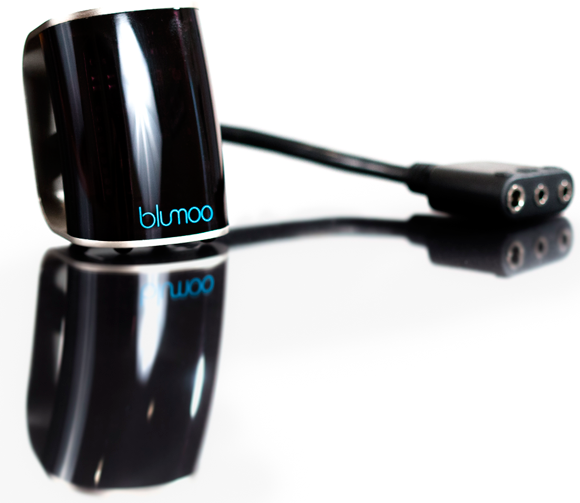
Image courtesy of Blumoo.
Figure 10-3: Blumoo’s base station sends signals to your home automation devices when you issue commands from your smart device.
The Blumoo base station contains an IR (infrared) blaster that awesomely bounces IR commands off your walls, cabinets, and just about anything else it needs to in order to make your home entertainment devices jump at every command.
Another cool feature about Blumoo is that you can connect a speaker directly to the base station so you can stream music from your smart device. Connect the Blumoo to your home sound system and you can stream throughout the joint. Sweet.
The Blumoo app allows you the freedom to take control of your home theater:
- Download preconfigured virtual remotes for all your entertainment devices. More than 225,000 devices are supported!
- Customize the virtual remotes by moving, deleting, or adding buttons.
- Create macros that enable you to perform multiple actions with the touch of just one button. For example, create a macro that will power all your entertainment devices on or off at once.
However, the same complaint I have regarding Roomie applies here: The only way to get support for your Blumoo is through email. The actual quote I heard on one of the support videos was that you could send an email if you ran into problems or had questions during setup and someone “will get back to you shortly.” Shortly? What does that mean, exactly? A few minutes after you send the email? As soon as possible on the next business day if you happen to be setting up your Blumoo after the company’s support team has gone home for the evening? Believe me, I understand that Blumoo isn’t a company that staffs its support center 24/7. No problem. But the customer should at least be given a better response time than “shortly.”
Do not let my support rant deter you from checking out the Blumoo site at www.blumoo.com. The site actually makes for fun reading.
Logitech
“You know, Dwight,” I can hear some of you saying, “I kind of like having a remote control in hand. I have to deal with my smart device all day long, and I like feeling the heft of a remote control chock-full of actual physical buttons.”
I hear you, friend, and so does Logitech.
Logitech is the creator of the Harmony line of universal remote controls, and they can scratch right where you itch when it comes to your actual (as opposed to virtual) remote control obsession.
Logitech’s Harmony devices vary in their capabilities, and therefore in price, but they all perform quite well in their intended roles.
The Harmony Ultimate One, seen in Figure 10-4, is the sole control you need to command your entertainment system.
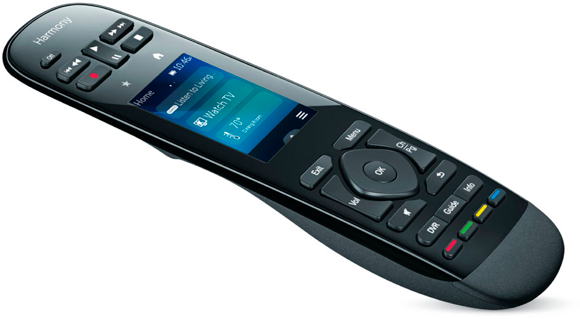
Image courtesy of Logitech.
Figure 10-4: Harmony Ultimate One is the remote you need if you want to use one device to control your home entertainment system.
Ultimate One features include:
- You can control up to 15 entertainment devices from just one remote.
- Button functions can be customized.
- The built-in touchscreen allows you to swipe through the menu, similar to your smartphone or tablet.
- It’s compatible with more than 270,000 home entertainment devices!
- It uses a charging station to recharge its batteries, so you will rarely ever change a battery for this remote, which is certainly a welcome change.
- You can add up to 50 favorite channels so all you need to do to change the channel is touch the icon for the channel you want to view.
The Ultimate One is a great device for handling your home entertainment system, and it’s also easy to set up using your Mac or Windows-based PC. Follow these steps:
-
Open your favorite web browser and go to
www.myharmony.com. - Click on the Sign In/Set Up link near the top of the page.
-
Click the Download Now link on the preceding page to download the MyHarmony software necessary for your computer.
The site will automatically detect your computer’s operating system and download the appropriate version for it.
- Install the MyHarmony software and launch it.
- Create an account if you don’t already have one, or sign in with your current account.
- Follow the on-screen instructions, as I’m doing in Figure 10-5 , to connect your Harmony remote to your computer and begin setting it up for use.

Image courtesy of Logitech.
Figure 10-5: Set up your Harmony Ultimate One with software using your Mac or PC.
Once you’ve gone through the setup process, you can begin controlling your entertainment with an honest-to-goodness in-your-hand remote control, with real buttons and everything.
Go to www.myharmony.com to see a list of Harmony remotes and other accessories, such as a keyboard, to make using your home entertainment devices that much easier.
Apple
Streaming video has been around on the Internet for quite the while, but only recently has it begun to be viewed on televisions and smart devices by a significant amount of folks. This is due to the advent of streaming media devices that make it simple to put streaming content onto your TV.
One such device, and one of the most popular in its category, is the Apple TV (see Figure 10-6).
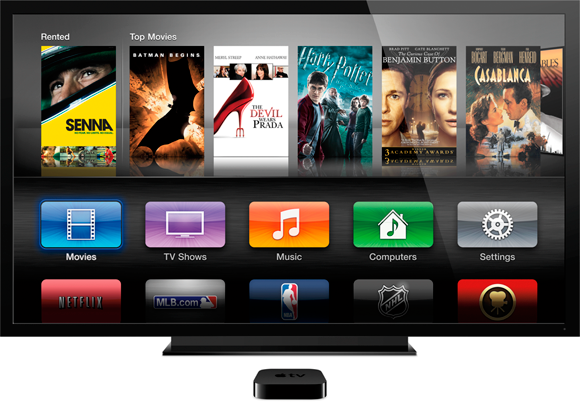
Image courtesy of Apple, Inc.
Figure 10-6: Stream video from the Internet, and even from your computer or iOS smart device, with the help of Apple TV.
Apple TV’s features are as long as my arm:
- It supports up to 1080p HD video.
- Set up your iTunes account information to access your iTunes content on your television.
- Play your iTunes music on your TV or speakers.
- Access content through the apps of your favorite providers, such as:
- Crackle
- Disney
- ESPN
- Fox
- HBO
- History
- Hulu Plus
- MLB
- NBA
- Netflix
- NFL
- Showtime
- YouTube
- Stream content from your Mac or iOS devices using AirPlay.
- View content you have stored in iCloud, such as your photos or personal videos.
- Watch movies you’ve created with your Mac with iMovie Theater.
- Share content that other family members have purchased using Apple’s Family Sharing.
- Mirror content from your other devices so that others can watch the action on your TV, as shown in Figure 10-7.

Image courtesy of Apple, Inc.
Figure 10-7: Mirroring allows you to show the exact content that’s on your iOS smart device or Mac on your television.
There’s even more to Apple TV than I have space to discuss, but you get the picture by now.
Apple TV simply connects to your television with an HDMI cable. Once they’re connected, enable Bluetooth on your iPhone or iPad and hold it close to the Apple TV; the Apple TV uses this momentary connection to glean your Wi-Fi network’s settings from the iPhone or iPad. Everything will be up and running in no time.
Once you have it working, you can control Apple TV using its remote control, which is included, or you can download and use the Remote app on your iOS smart device. Whether you’re an Apple fan or not, whether you have a Mac or Windows PC, you should give the Apple TV a look. Check it out at www.apple.com/appletv, or you can see it at your local Apple Store. (Other stores, such as Best Buy, also may have demos of Apple TV for you to see.)
Roku
Founded in 2002, Roku is one of the first companies to put forth a streaming media player. As such, it is also one of the most popular, having sold literally millions of its Roku players, like the Roku 3 in Figure 10-8, over the years.

Image courtesy of Roku, Inc.
Figure 10-8: Roku’s latest and greatest streaming media player: the Roku 3 (with its accompanying remote control and headphones).
The idea is simple: Build a little box, fill it with streaming media apps from various outlets, connect it to the Internet and your television, and open a world of streaming media that is hard to beat. You’ll have thousands of television shows and movies right at your fingertips, and you can watch them all whenever you feel like it.
Roku’s been at this a while, and it also doesn’t have ties to any other internal interests. For example, Apple wants you to use iTunes, and as such, you can only use Apple TV with it. There are other examples of this practice, as well, but Roku doesn’t have any other interests than selling you a streaming media player. Roku doesn't care what TV you use to play the video or listen to the music on (it also supplies music channels, not just video). More than 1,800 channels are available for your perusal on Roku. I know that sounds like an amazing array of TV nirvana, and in some ways, it is (Roku gives you most of the main streaming channels you could hope for, with the notable exception of iTunes), but please understand this: The vast majority of the channels are jokes. Not the funny kind either, but the roll-your-eyes-and-pass-on-by-with-a-disgusted-look kind. But that shouldn’t detract from Roku’s other shining features. Just don’t expect that you’ll find something for you and your family on every channel. Ain’t gonna happen.
Roku currently offers four versions of its player:
- Roku 1
- Roku 2
- Roku 3
- Roku Streaming Stick, shown in Figure 10-9

Image courtesy of Roku, Inc.
Figure 10-9: The Streaming Stick is easy to hide behind your TV.
Every Roku player comes with the following:
- 1,800+ channels of streaming multimedia
- Up to 1080p HD
- Built-in Wi-Fi to stream content from your network
- Access to the Roku app for your smartphone or tablet
- A Roku remote, some with built-in headphones (depending on the model)
You can view a head-to-head comparison of all the Roku models so you can determine which best suits your needs: Just visit www.roku.com/products/compare.
The Roku app affords you another way of controlling your Roku device. You can search for content and instantly send it to your Roku, switch between more than one Roku device, and more. But the best feature to me is that you can use the app as another remote (see Figure 10-10), because in a home with four children you’re bound to lose the physical remote at some point. With the Roku app, just fire up your smart device, open the Roku app, and you’re back in business.

Image courtesy of Roku, Inc.
Figure 10-10: The Roku app can also act as a backup remote, or you can use it as your primary remote if that suits you best: Choice is nice, isn’t it?
Roku’s website, www.roku.com (fancy that), can answer all your Roku questions, and will also let you see the cornucopia of channels available.
Google is another of the technology big dogs that started out doing something altogether different (Internet search engine) and has morphed into a company that dabbles in quite a diverse range of ventures. One of those ventures is into television sets.
Google stepped into the television market with the advent of Google TV in 2010, but that might have been better categorized as a slight misstep. Google TV is fading away (as of 2014), and Google has launched the Nexus Player running the Android TV operating system. The Nexus Player, shown in Figure 10-11, has a lot of promise, but since it was just released in November 2014, it has some catching up to do in regards to its competitors. Nexus Player provides the standard apps for watching streaming media, such as Netflix and Hulu, and you can cast shows from your smart devices to it (like Google’s own Chromecast, which I discuss next), but more developers need to get on board for the Player to really put a dent in the market.

Image courtesy of Google.
Figure 10-11: Nexus Player is Google’s latest attempt at giving you an Android-based streaming media platform.
One big thing about Nexus Player, or more accurately, the Android TV operating system, is that you will be able to use your standard Android apps with it. In other words, apps that you install on your Android smartphone or tablet can also be installed on your Android TV. This will give you tons of flexibility and consistency between your Android devices.
However, Google’s main attention-grabber when it comes to getting Internet and computer-based content to your TV is its Chromecast. The Chromecast, shown in Figure 10-12, is a dongle that you plug into the HDMI port on the back of your television.
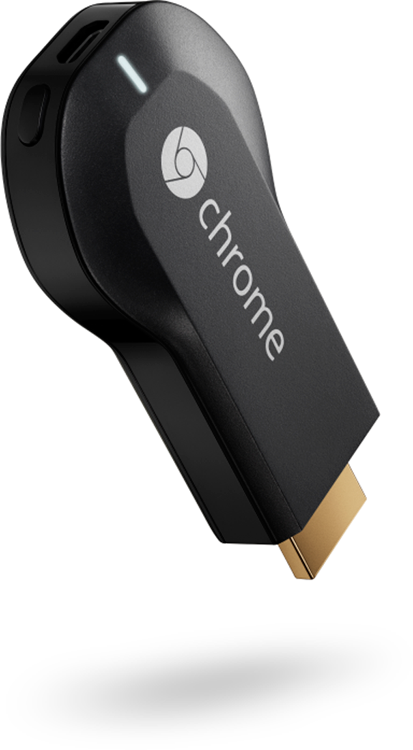
Image courtesy of Google.
Figure 10-12: Google’s Chromecast allows you to play content from your computer or smart device on your television through your Wi-Fi network.
Chromecast was an instant hit for Google. It has a small footprint and a small price point: $35 is all you need to start casting to your television.
Chromecast is easy to set up. Follow these steps:
- Plug your Chromecast into one of the HDMI ports on your television.
- Chromecast uses USB for power, so you can either plug its USB connector into a USB port on your television or connect it to the USB power adapter and plug the adapter into a standard outlet.
-
Go to
www.google.com/chromecast/setupfrom any Mac or Windows computer, or from any iOS or Android smart device, and then download the Chromecast app for your device when prompted. - Open the downloaded Chromecast app and follow the instructions for setting up your Chromecast to work with your network.
I almost forgot to mention one tiny thing: In order to cast from your Mac or PC, you’ll need to download and install Google’s Chrome web browser. It’s the only browser that can (currently) cast its content to the Chromecast. However, you will need to install the Google Cast extension in order to do so. To get and install the extension, follow these steps:
-
Open the Chrome browser on your computer.
The extension is not supported on mobile web browsers.
-
Visit
www.google.com/chrome/webstoreand click the blue Visit Chrome Web Store button. - Type Google Cast into the search field in the upper-left corner of the resulting page and press Enter or Return on your keyboard.
-
Find Google Cast under the Extensions heading and click it.
You may need to scroll down a bit to find it. A new window opens within the browser window to extol all the features that Google Cast can offer.
- Click the blue Free button in the upper-right area of that window to install the extension.
- Restart Google Chrome (completely quit and reopen it) to activate the extension.
- To cast the contents of a page in your Chrome browser, click the Cast button in the upper-right corner of the Chrome window, circled in Figure 10-13 .

Figure 10-13: Click the Cast button in the Chrome browser to send the contents of the browser window to your TV.
The cool part is that anything you view in the Chrome browser can be displayed on your television using the Chromecast.
Bose
If you’ve ever heard Bose speakers, you’ve never forgotten the great sound they put out. I’m not saying other speaker makers aren’t as good as Bose, but I’m not sure that there are many (if any) that surpass it. Bose has been around for 50 years, and it is still a leading innovator in sound technology.
The Bose SoundTouch line of Wi-Fi–enabled speakers, shown in Figure 10-14, are wireless speakers that you can place throughout the house and wirelessly play your tunes on, using your iOS or Android smart device to run the show.
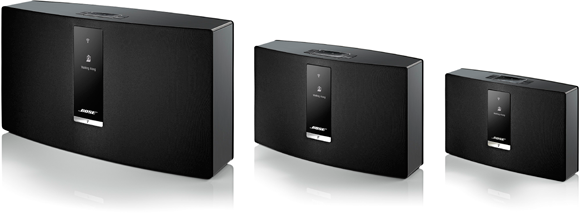
Image courtesy of Bose Corporation.
Figure 10-14: The SoundTouch line of speakers sound great, look great, and are easy to manage from your smartphone or tablet.
SoundTouch speakers come in three flavors, shown from left to right in Figure 10-14:
- SoundTouch 30 is made to fill larger spaces with rich Bose sound.
- SoundTouch 20 is designed for average-sized rooms.
- SoundTouch Portable is also for average-sized rooms, but is also portable, so you can take it to any room of the house with ease.
All the models share the following features:
- Connect directly to your favorite streaming music platform (such as Pandora, Spotify, and others) or Internet radio stations.
- Stream music from your personal music library.
- Each model comes with six preset station options. You configure the stations using the SoundTouch app, which comes free with your SoundTouch system, and you can access stations with the press of a single button on the speaker itself.
- SoundTouch speakers connect to other SoundTouch speakers, creating their own speaker network throughout your home. You can play the same song throughout your home or play different songs on each speaker.
The SoundTouch app is available for iOS and Android systems. The one feature where iOS users will have an advantage over Android users is that SoundTouch speakers incorporate Apple AirPlay compatibility natively.
Check out the SoundTouch range of speakers, as well as other SoundTouch devices, by going to www.bose.com and clicking on the Wi-Fi Music Systems tab.
Sonos
Since I'm discussing speakers, I would be remiss not to mention the folks who really got the Wi-Fi speaker craze started: Sonos.
Sonos has been on top of its game, and this market segment, since 2002, and it shows no signs of slowing down. While competitors are continually launching products that come close, so far none have surpassed Sonos’s line of Wi-Fi–enabled sound systems.
Sonos offers a full range of what it calls HiFi wireless speakers to suit your needs:
- SUB is a wireless subwoofer that gives you as much bass as you can stand. The SUB, shown in Figure 10-15, pairs with any of the Sonos line of speakers.
- PLAY:1 is a compact speaker that delivers big sound in a small package. This little guy offers what Sonos simply labels as Loud Sound. Get two PLAY:1 speakers to deliver rich stereo sound in small spaces, or to complement a home theater system as great rear speakers.
- PLAY:3 is the Sonos speaker that delivers what the company terms as Really Loud Sound. This speaker is designed for average-sized rooms and provides a deeper level of bass than the PLAY:1, but it can also be used in a home theater system as a great rear speaker.
- PLAY:5 is the big boy of the bunch, providing Crazy Loud Sound (Sonos’s description) and Crazy Deep Bass (also from Sonos). The PLAY:5 is meant for larger spaces and is designed to be the main player in your music system.
- Already have an existing wired music system, but want to make it wireless? The CONNECT:AMP connects to your system and does just that, allowing you to broaden your wired horizons.
- PLAYBAR, shown in Figure 10-16, is the ultimate offering from Sonos. This bar not only connects to your music system, but also to your television, and the sound that issues forth from it is nearly flawless.

Image courtesy of Sonos, Inc.
Figure 10-15: Get ready for some seriously d-e-e-p b-a-s-s with Sonos’s SUB wireless subwoofer.
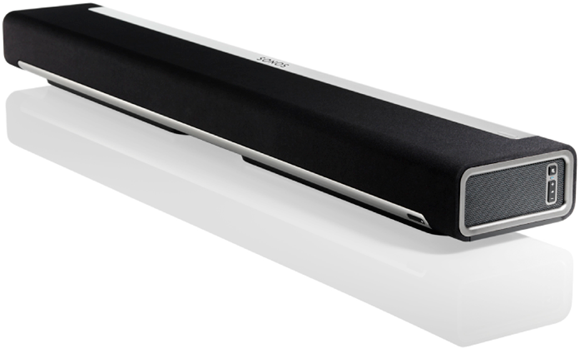
Image courtesy of Sonos, Inc.
Figure 10-16: Sonos’s PLAYBAR is a Wi-Fi music and sound lover’s dream, and it looks really cool, too.
The entire Sonos system can be controlled from your iOS or Android smart device using the Sonos app. You can control as many Sonos devices as you like using the app, playing different songs on separate speakers, or playing the same tunes throughout your home.
Sonos allows you to connect your speakers directly to your Wi-Fi, but a feature that you’ll really love is the capability to create your own separate Sonos Wi-Fi network. This prevents the Sonos devices from using valuable bandwidth that your other wireless devices so desperately crave; it makes your wireless sound more stable (which Sonos devices are already known for being); and it extends your Sonos wireless network with every device you install.
Check out the Sonos website, www.sonos.com, for more information on its wonderful devices than I could ever pack into this chapter.
Happy listening!

 Currently, Roomie is an iOS-only device (at the time of this writing). However, Roomie does state on its site that Android compatibility is something it hopes to incorporate in 2015. The company claims this has allowed the development process to proceed much faster than it would have had Roomie supported Android from the outset, and I can’t fault that argument.
Currently, Roomie is an iOS-only device (at the time of this writing). However, Roomie does state on its site that Android compatibility is something it hopes to incorporate in 2015. The company claims this has allowed the development process to proceed much faster than it would have had Roomie supported Android from the outset, and I can’t fault that argument. Since Blumoo doesn’t use Wi-Fi to communicate, that’s one less drain on your network’s bandwidth. Another plus is that the Blumoo won’t stop communicating with your devices if your Wi-Fi isn’t working.
Since Blumoo doesn’t use Wi-Fi to communicate, that’s one less drain on your network’s bandwidth. Another plus is that the Blumoo won’t stop communicating with your devices if your Wi-Fi isn’t working. The Chrome browser, while it is currently my favorite and the favorite of many a web surfer, is known as being a bit of a memory hog. When Chrome was first released, I loved its speed and interface, but eventually had to walk away because it was simply overtaking my computer’s memory. (I had this experience on both Macs and Windows machines.) However, I did come back after a few updates had been made to Chrome and have found it more manageable. From time to time, though, I do find myself having to restart the browser to reclaim huge chunks of memory. Chrome is a great browser, but when you first start to notice everything on your computer slowing down, completely quit and restart Chrome to see if that does the trick.
The Chrome browser, while it is currently my favorite and the favorite of many a web surfer, is known as being a bit of a memory hog. When Chrome was first released, I loved its speed and interface, but eventually had to walk away because it was simply overtaking my computer’s memory. (I had this experience on both Macs and Windows machines.) However, I did come back after a few updates had been made to Chrome and have found it more manageable. From time to time, though, I do find myself having to restart the browser to reclaim huge chunks of memory. Chrome is a great browser, but when you first start to notice everything on your computer slowing down, completely quit and restart Chrome to see if that does the trick.